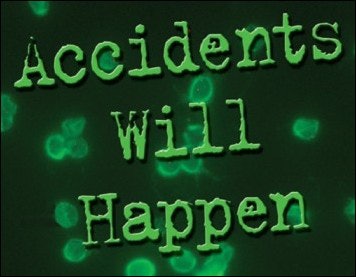But How Do Aquatic Facility Operators Handle Them?

Years ago, movie audiences rolled in the aisles when, in Caddyshack, an airborne Baby Ruth candy bar landed in a swimming pool, scattering panicked bathers in a classic case of mistaken identity. While the general public may still find the scene hilarious, such a circumstance would be no laughing matter for today's pool operators, nor for anyone who has suffered severe illness caused by a pool-borne disease. Fecal accidents in swimming pools and aquatic facilities have become a serious issue, carrying potential health risks to swimmers and causing costly disruptions to facility operations.
How to minimize these incidents and how to responsibly deal with them when they occur has been the subject of some debate. It is clear that some design elements that have given the modern family aquatic center its popularity may be unintentionally exacerbating this problem. Modifications to future designs can help reduce health and operational risks. In addition, properly trained operators and efficiently managed mechanical and sanitation equipment can help keep swimmers safe and operational disruptions to a minimum.
Health risks associated with public aquatic facilities are nothing new, as anyone old enough to remember the polio outbreak of the 1950s will attest. Modern medicine, along with sophisticated contemporary designs in aquatic facility sanitation and recirculation equipment, have made public swimming an extremely safe leisure and fitness activity.
Recently, however, highly publicized incidents involving contraction of potentially life-threatening bacterial disease from contaminated pool water have caused the industry and public health officials to look more closely at the risks involved in these facilities - and to reexamine appropriate responses to minimizing those risks.
During the peak of the swim season (Memorial Day through Labor Day), it is possible for a crowded public facility to experience reported fecal or digestive regurgitation contamination incidents as often as six to eight times a month (not counting incidents that may go unnoticed). Each carries with it the potential for bacterial and parasitic illnesses - although nationally, fewer than 10 diarrheal outbreaks linked to swimming pools are reported each year.
In addition to E. coli, other primary disease pathogens of concern in the pool environment are cryptosporidium, giardia and shigella. These illnesses carry with them varying degrees of symptom severity and potential health risk. According to the Howard Hughes Medical Institute in Chevy Chase, Md., E. coli causes at least 20,000 cases of bloody diarrhea and more than 200 deaths due to kidney failure annually in the United States, primarily among children and the elderly. (These results include all sources, not just aquatics.) According to the Centers for Disease Control and Prevention (CDC), crypto usually causes abdominal cramps and diarrhea in adults, who typically recover in two weeks, although individuals with compromised immune systems can die from the illness. Giardia can cause all or some of the following symptoms: diarrhea, dehydration, abdominal pain and weight loss.
There is no blood loss associated with the diarrhea, and the disease is not generally fatal. Most people infected with shigella develop diarrhea (often bloody), fever and stomach cramps within a day or two of exposure.
How dangerous are these disease pathogens in sanitized swimming pools? Again, the answer varies depending on the type of contamination and the pathogen in question. In 1999, the CDC collected samples from solid-formed fecal accidents at waterparks and pools around the nation and tested them for the presence of giardia and crypto. None of the sampled fecal accidents tested positive for crypto, while giardia was found in 4.4 percent of the samples. Yet, according to Michael Beach, an epidemiologist for the CDC, crypto "accounts for 80 percent of pool-borne diarrheal illness."
The reason is that crypto is the most resistant to standard sanitation levels. Shigella, for example, is typically killed within seconds if the water is properly chlorinated, according to the CDC's Division of Parasitic Diseases. Studies have shown that shigella outbreaks in public swimming pools are nearly always the result of improperly chlorinated water. E. coli, meanwhile, is typically killed in less than one minute by properly chlorinated water.
The parasite giardia is somewhat more resistant, capable of living in chlorinated water for approximately 45 minutes. But the crypto pathogen can survive more than 200 times longer - nearly seven days, or 9,600 minutes - in chlorinated swimming water. (There is some debate within the aquatic industry regarding the resistance period for crypto, because the tests to determine these times occurred in a laboratory atmosphere, not in actual pool conditions.)
Those facts leave pool operators in a quandary regarding how to respond to known and potential incidents of contamination. Do you treat formed-stool incidents with the same response as you would for diarrheal contaminations. The answers aren't easy, and it may be impossible to fully guard against any possible disease outbreak with one specific set of guidelines.
There are numerous areas, however, in which steps can be taken to provide both private and public sectors with the safest water possible. These range from the applications of low-cost operational protocols to moderate- to high-cost design refits of existing mechanical, circulation, sanitation and structural elements.
Maintaining a properly balanced and chemically treated pool is the easiest and best defense against pool-borne disease pathogens. When the pool is properly sanitized, it is able to quickly respond to increased bather loads and maintain minimum sanitizing levels.
Pool chemicals possibly have the greatest impact in combating these bacteria and parasites. As previously mentioned, free chlorine at neutral pH, maintained at proper levels throughout the pool, kills E. coli (the most commonly found bacteria) in less than a minute. Even more-resistant pathogens like hepatitis A, giardia and cryptosporidium will be controlled by proper chemical maintenance, though the effective period varies.
The CDC recommends maintaining disinfectant levels as follows: optimal pH, 7.4 to 7.8; alkalinity, 80 to 120 parts per million; calcium hardness, 200 to 400 ppm; and total dissolved solids, below 2,500 milligrams per liter. As most pool operators know, pH imbalance can drastically reduce the effectiveness of chlorine. The Certified Pool Operator (CPO) handbook suggests checking chlorine levels both with chemical controllers and at poolside. If chemical controllers are used and are placed in the pool's mechanical space, management should consider providing this information at the pool deck. Following a fecal accident, it is necessary to modify normal chemical levels.
In conjunction with maintaining recommended chemical balances, it is also important that the pool be filtered properly. In addition to recommended backwashing and maintenance operations, the filters should also be inspected regularly to make sure that breakthrough does not occur, and that units are capturing all the particulate matter they are designed to capture in proper operation.
Of course, quality-control procedures such as these don't happen on their own. While there are many excellent automatic, computer-controlled systems in operation today, they all still rely on oversight by professionally trained, highly competent operators, managers, lifeguards and other staff.
Certifications such as CPO and AFO (Aquatic Facility Operator) are crucial to the hands-on monitoring of today's high-volume aquatic facilities. These not only help facility operators utilize more-sophisticated sanitization systems, but also help effectively train and manage pool staff. Facility managers can't be everywhere, and thus rely on lifeguards (for example) to take steps to prevent fecal accidents and to maintain proper procedures in the event that an accident does occur.
Posting signage at the entrance and key traffic points throughout the facility can help lifeguards enforce safety policies. In addition to the postings required by state and local codes, signage should include a requirement for swimmers to take a full shower, with complete washing of the body, prior to entering any pool. The wording of this signage can be applied at the operator's discretion. Signs should also include language that prohibits use of the pool by swimmers experiencing diarrhea within the past two weeks. Additional warnings may be included for swimmers with compromised immune systems (such as persons with AIDS, those who have received an organ transplant or those receiving certain types of chemotherapy), since these swimmers are at the highest risk of infection.
In addition to instructions for the patrons, each facility should have a well-defined, written contamination plan, and all staff members should be knowledgeable about this plan through in-service training. A copy of the "Environmental Health Outbreak Investigation Report for Swimming Pool Venues" is available through the CDC, and can be helpful in providing guidelines for developing your own contamination response plan.
Aquatic facility design has undergone a complete makeover during the past 10 to 20 years, responding to the changing demographics and interests of the swimming public. Once defined by rectangular competition pools with separate diving tanks and kiddie pools, the industry has welcomed a new generation of family-friendly aquatic facilities characterized by larger, shallower free-form bodies of water with zero-depth entry, water slides, current rivers and interactive play features. While these facilities have met with near-unanimous approval by their users, some of the features that make them friendly are the source of many of their operational challenges.
Those separated kiddie pools of yesteryear, so maligned today, had one benefit: They were small bodies of water isolated from the main tank. When a fecal accident occurred, it was easy to drain the pool, sterilize the tank and refill it, with no disruption to the main body of water.
Family aquatic facilities, on the other hand, are frequently designed to function with a single mechanical, circulation and sanitation system. Furthermore, their design intentionally encourages family members of all ages to play and lounge in one area. The result can be the introduction, by toddlers, of a disease pathogen into the entire body of water. According to the CDC, even swim diapers are unlikely to prevent diarrhea from leaking into a pool. Whatever the source, the contamination (and potential shutdown) of an entire facility carries a substantial risk for pool operators.
Does this mean modern facilities are flawed and should be closed down? Not at all. Advances in sanitation systems and a heightened focus on proper management make these facilities extremely safe. Still, certain design alterations can be made to further improve facility safety.
The easiest and least costly solution to the toddler problem is to create a separate body of water for toddlers featuring "quick-dump" capability for rapid drain and refill of the affected tank. For example, a toddler play area with 1,000 gallons of water could be rapidly drained directly into a sanitary line, the area sanitized, and then the pool refilled with water from an adjacent pool that is already filtered and chemically treated.
A slightly more costly option would be to increase the turnover rate for returning filtered, sanitized water to the pool. Such a system would require larger pipes, larger pumps and larger filters, which would result in an additional construction cost of $10,000 to $20,000 for a 10,000-square-foot, 400,000-gallon aquatic facility.
A third design option is to physically and mechanically separate each body of water beyond merely isolating the kiddie pool. By doing so, operators can reduce the risk of having to close down an entire facility because of a single incident. Running parallel mechanical systems will add $50,000 to $100,000 per system to the construction costs of a typical facility.
The problem of waterborne bacterial and parasitic disease pathogens is a serious one, and the challenges inherent in controlling and preventing problems should neither be ignored nor minimized. But with proper attention given to professional operation of facilities, training of facility operators and staff, education of patrons and possible design improvements to future facilities, public aquatic facilities can continue to provide safe, healthy opportunities for leisure activities for families and communities.




































